SaaS SEO refers to search engine optimization in software as a service type of product. In fact, SaaS SEO is the process of optimizing a SaaS website for search engines to increase visibility, traffic, and customer acquisition. When building a SaaS product, it is essential to have a robust online presence and an effective SEO strategy because SaaS companies operate in a highly competitive and evolving market.
Some common SaaS SEO tactics include keyword research, on-page optimization, content creation, link building, and technical SEO. So, you can track and analyze key metrics such as traffic, conversion rates, and customer acquisition costs to continuously refine and improve the SEO strategy.
At Codica, we are actively engaged in SEO to optimize and promote our website and improve the performance of our clients’ projects.
In this article, we'll show the unique components of SaaS SEO to improve your website's visibility in search engines, attract more qualified leads, and drive growth for your business.
Let’s get started!
Explanation of SaaS search engine optimization
To understand in as much detail as possible what SaaS SEO is and why it is needed, let's analyze this definition in parts.
Software as a service is a cloud computing model in which software applications are hosted on the Internet. These applications are accessed over the Internet using web browsers or mobile applications. Unlike traditional client/server models, SaaS providers host clients in their data centers and provide access to these services over the Internet.
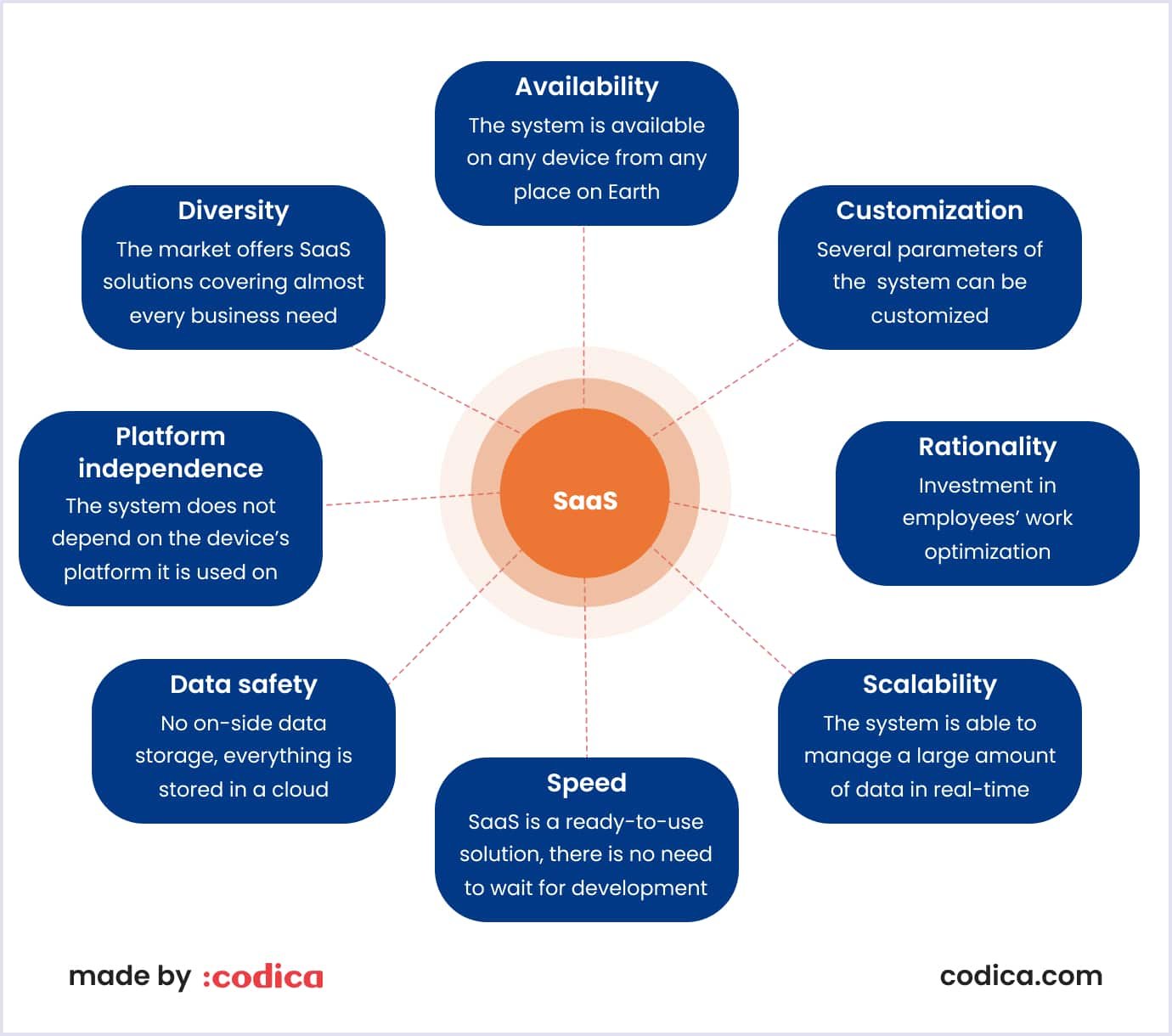
Then, SEO is the practice of influencing the visibility of websites or web pages in search engines. Generally, the earlier (or higher on the page) and more often a site appears in the search results list, the more visitors it will receive from search engine users. These users can return to the site whenever they find something new that interests them.
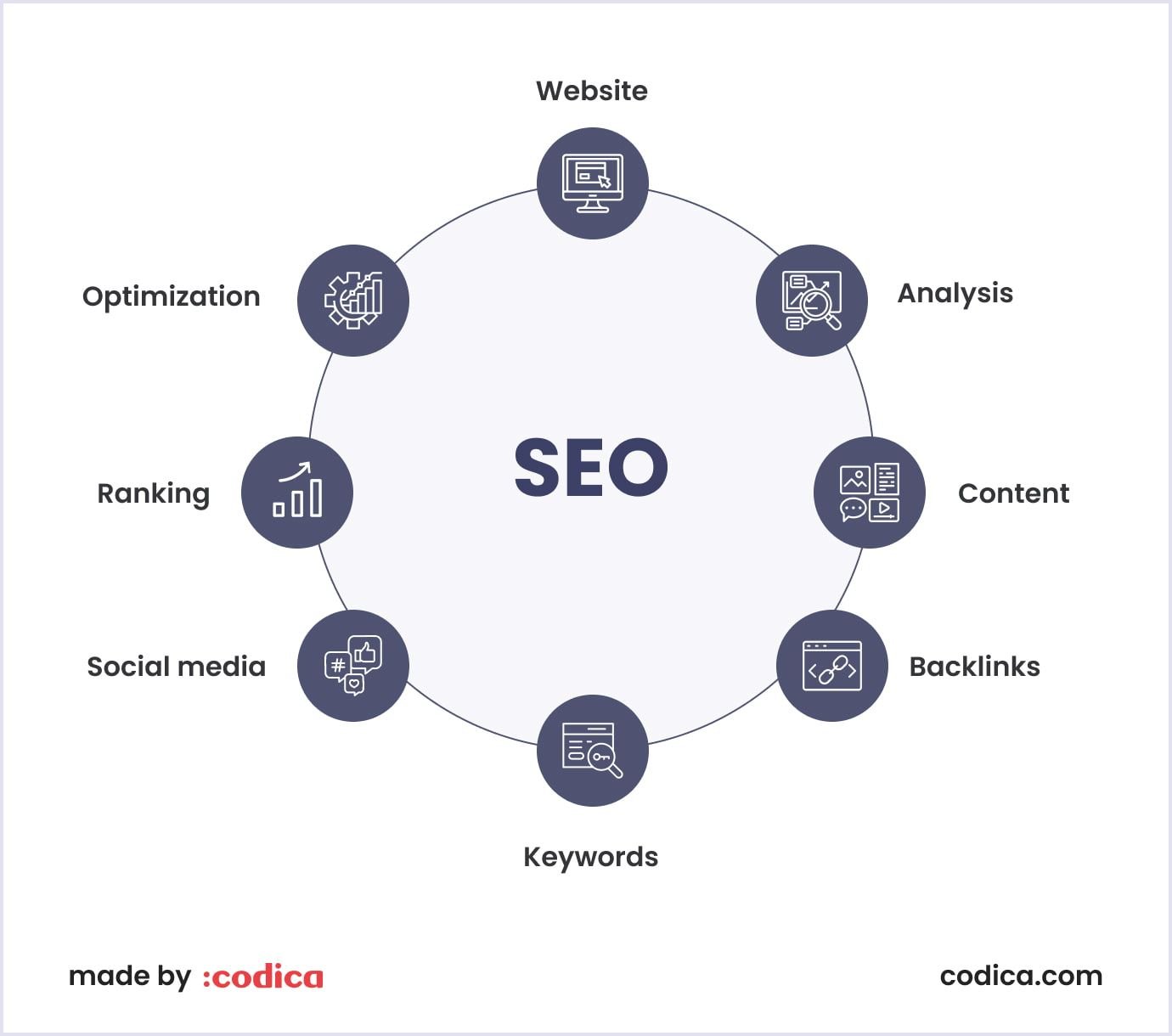
In combination, SaaS search engine optimization is a specific type of SEO practice used for SaaS products. The primary goal of SaaS SEO is for the product to achieve high positions on search engine results pages (SERPs).
You may also like: 10 Biggest Problems for SaaS Companies and How to Solve Them
Importance of SEO for SaaS development
In fact, SEO is one of the most essential parts of any B2B SaaS business. With SEO, you can drive business growth, reduce costs, and engage customers from various marketing platforms.
Let's take a closer look at the role of SEO for SaaS businesses.
Drive exponential growth
A well-optimized website can help attract more traffic from search engines, leading to higher visibility and exposure to potential customers. This can result in an increase in sign-ups, subscriptions, and sales, driving exponential growth for the SaaS product.
Lower cost-per-acquisition
SEO can help lower the cost-per-acquisition (CPA) by reducing the dependence on paid advertising. A higher ranking on the SaaS product's SERPs helps attract organic traffic and reduce CPA.
Engage customers from other marketing platforms
SEO enables SaaS companies to connect with new users through different channels. Next, SEO involves optimizing the website's user experience, making it easier for visitors to navigate, find information, and convert. By improving user flow and providing a seamless experience, SaaS companies can enhance engagement, increase customer satisfaction, and drive conversions.

Basic SaaS SEO ranking factors
SaaS companies can greatly benefit from search engine optimization to drive website traffic and improve online visibility. Also, SaaS businesses can incorporate E-E-A-T (experience, expertise, authoritativeness, and trustworthiness) principles into their SEO strategies to improve their online presence and credibility.
So, let's go deep into the specifics of each of these ranking factors.

User engagement metrics
These metrics are an essential part of search engine optimization for SaaS websites. User engagement metrics indicate if customers like your website. These metrics include bounce rate, time spent on site, pages per session, and click-through rate (CTR). With them you can improve your search engine rankings.
- Bounce rate marks the number of visitors leaving your site after viewing only one page. So, you get a high bounce rate if customers do not find what they need on your site. As a result, it can negatively impact your search engine rankings.
- Time on-site metric indicates how long visitors stay on your site. If users spend a long period of time on your site, it can guarantee that you provide valuable and relevant information on your SaaS platform.
- Pages per session metric measures the number of pages a user views on your site during a single session. There is a simple formula: the more pages users view, the more likely they find your site helpful. This can positively affect your SEO rankings.
- Click-through rate (CTR) defines the share of users who click on a link to your site from search engine results. Therefore, a high CTR can indicate that your site is exciting and valuable to users.
Technical structure and usability
The site's structure should be logical and easy for users and search engines to understand. Moreover, the site should be well organized, with a straightforward menu and well-placed links.
Nowadays, most users use mobile devices to search the Internet. Therefore, the site should be mobile-optimized to ensure convenient and quick access to information.
On the other hand, the page loading speed can affect your site's ranking in search engines. The faster the page loads, the bigger the chances of a higher ranking.
Content quality
Focus on creating quality content to optimize your website for search engines. This content should provide valuable information to your visitors by posting how-to guides, software comparison guides, and more. It should be unique, exciting, and useful for your target audience. This can include blogs, e-books, videos, and other forms of content.
To get content ideas, you can simply put your competitor in the Ahrefs site browser and go to the Top Pages section to see which pages bring in the most traffic. And if you can create better content, feel free to do so!
You can also share new content on websites related to your industry. This will show Google that you are relevant and trustworthy in the industry.
The quality content brings reliable links to your site, which we described in the next block on how to drive traffic and authority back to your site.
Backlink metrics
It is well-known that backlinks are when one website links to another with an anchor text. When someone clicks on these links, they go to the sites mentioned.
Search engines analyze how often other websites link to yours to determine reliability. To collect this data, you need to create linkable content, known as link bait, where you conduct research and statistics.
As for manual creation, you can list your product in popular guides, review sites, and authoritative sources.
Brief comparison table of SEO ranking factors
Below, we have compared primary SaaS search engine optimization ranking factors. Note that these ranking factors are not independent of each other and often interact to influence a site's overall SEO performance.
| Ranking factor | Definition | Importance |
| User engagement metrics | Metrics that measure how users interact with a site or app, such as bounce rate, time on site, pages per session, etc. | They indicate that users find the site helpful and engaging. Google rewards sites that keep users longer and promote more engagement. |
| Content quality | The quality, relevance, and usefulness of the content on a site, including text, images, and video. | Google's main goal is to provide users with the best and most relevant results for their search queries. Sites with high-quality content that meets user needs are more likely to rank well. |
| Backlink metrics | The quality and quantity of links pointing to a site, including the domain authority and page authority of linking sites. | Backlinks are a key factor in how Google determines the relevance and authority of a site. Sites with a lot of high-quality backlinks pointing to them are more likely to rank well. |
| Technical structure and usability | Factors that impact the technical structure and usability of a site, such as page load speed, mobile-friendliness, and site architecture. | Google wants to provide users with a good user experience, and technical issues can detract from that experience. Sites with good technical structure and usability are more likely to rank well. |
Our ultimate guide on how to build a SaaS SEO strategy
It is time to enter the world of SaaS SEO strategy – a powerful toolkit tailored to move these innovative experiences to the forefront of search engine results. By implementing a comprehensive SaaS SEO strategy, companies can increase online visibility, attract more qualified leads, and drive sustainable growth in a competitive digital landscape.
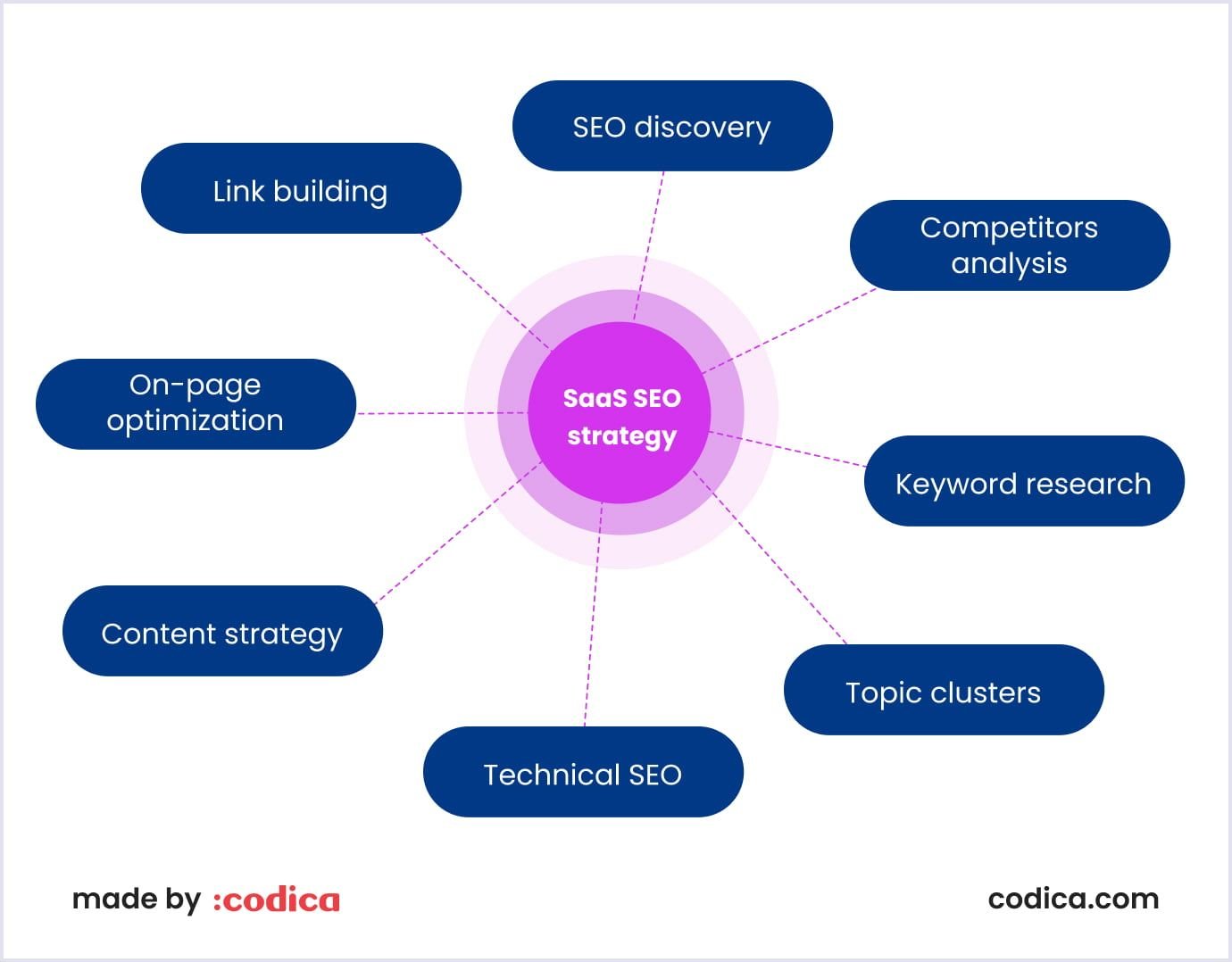
Now, let’s analyze the entire process of creating an effective SEO strategy for SaaS.
Step 1. SEO discovery
In a nutshell, this is the first stage in creating an SEO strategy for SaaS. This phase includes auditing your site to identify potential SEO issues and determine which elements on the site need improvement. It is also recommended that youspecify your primary keywords and concepts.
What should you do before creating a search engine optimization strategy for SaaS?
The first thing to do is create an Ideal Customer Profile (ICP). So, ICP is developed to filter and define your ideal customer who will buy your premium packages, have long-term retention, and generate revenue. Moreover, the ICP is determined based on age group, industry, job title, revenue, and company size metrics.
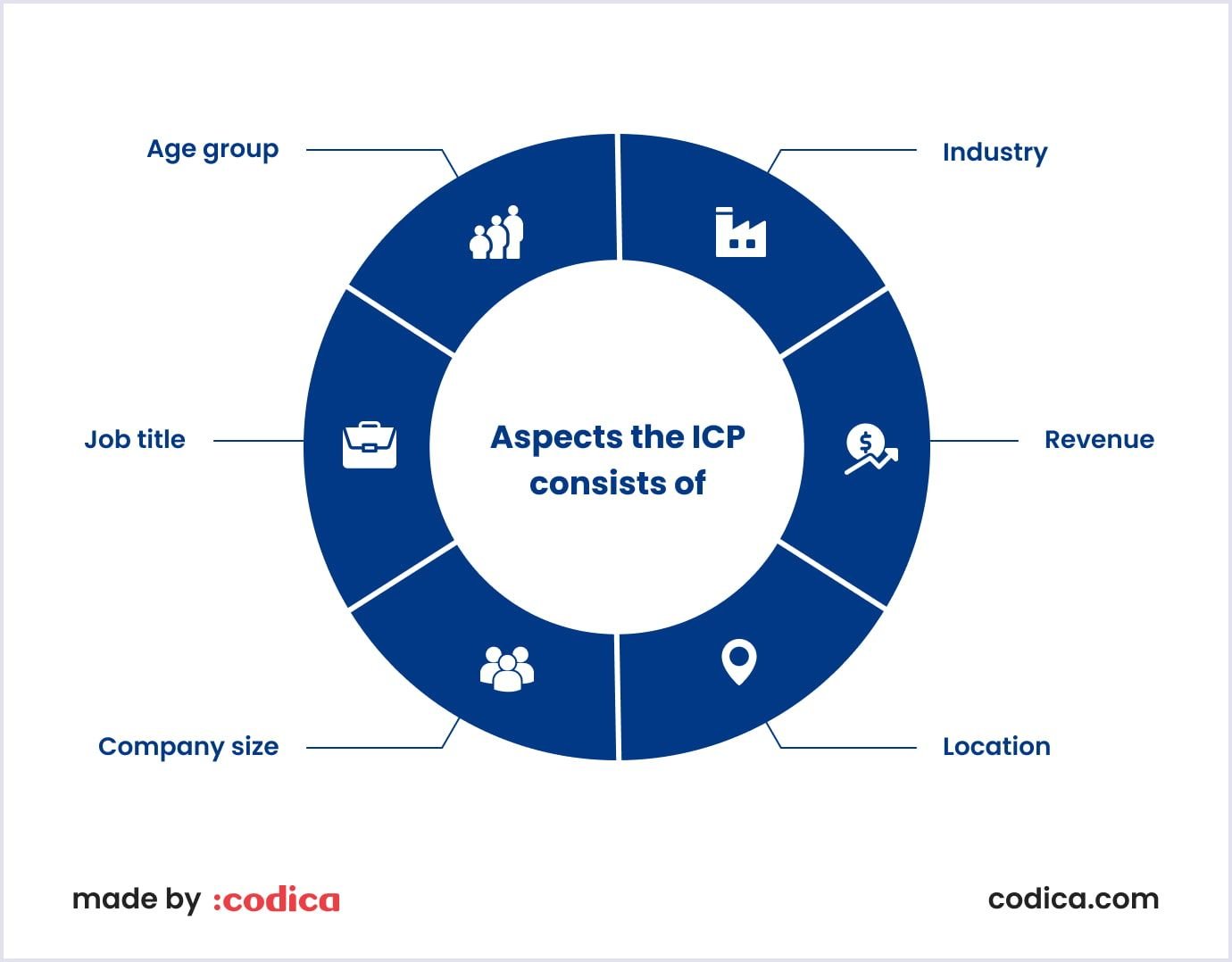
At Codica, our clients' ICP depends on their target market, age group, industry, specific services, location, and business size. For example, let's analyze our client, Celso Prado, to gain a detailed understanding of ICP.
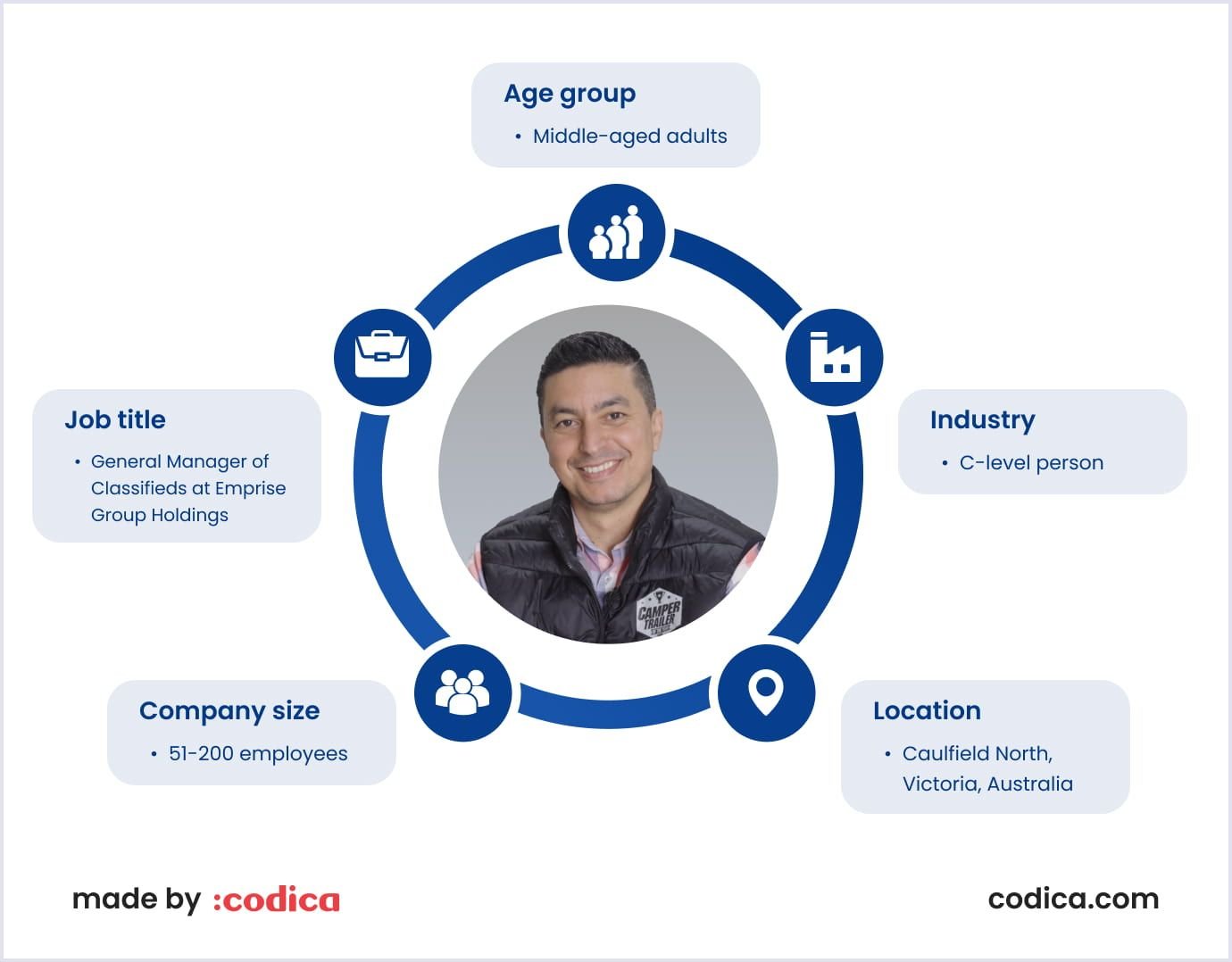
Next, you should create a SaaS SEO strategy with the end user in mind. Your company must clearly define its target audience and goals before choosing ways to sell its product. Ultimately, you will create a more effective marketing plan, leading to improved search engine rankings and increased revenue.
In summary, while the ICP focuses on creating a detailed profile of the ideal customer, the end user refers to the actual consumer of the product or service. On the other hand, the target audience covers the specific group(s) of people that a business aims to reach and engage with its marketing efforts.
All in all, this step aims to identify gaps in your current SEO efforts and opportunities to improve your website's visibility in search engine results pages (SERPs). When conducting an SEO discovery, pay attention to the following:
- Review your website's technical aspects, including site speed, mobile responsiveness, and structure.
- Check your website's on-page SEO factors, such as meta descriptions, headings, and content, to ensure they align with your target keywords and provide value to your target audience.
Step 2. Competitor analysis
This step includes researching competitors in your segment and determining their keywords, technical parameters, and content strategies. This will help you understand their SEO strategies and identify gaps that can be exploited to improve your site.
Competitor analysis is critical in identifying opportunities and areas for improvement in your SaaS search engine optimization strategy. When analyzing your competitors' SEO strategies, it's a great idea to follow some tips such as:
- Identify your top competitors in the SERPs for your target keywords. Use tools like Semrush, Ahrefs, or Moz to analyze their backlink profiles, content strategies, and website structure.
- Determine what your competitors are doing well and what you can do better.
- Pay attention to your competitors' on-page SEO factors, such as page titles, meta descriptions, and headings. These elements can provide valuable insights into what keywords and topics your competitors are targeting and how they structure their content to rank in the SERPs.
Step 3. Keyword research
In fact, keyword research is a critical component of any successful SaaS SEO strategy. It involves identifying the most appropriate and high-value keywords for your product and target audience.
Using keyword research tools such as Google Keyword Planner, Semrush, or Ahrefs is a great idea. These tools will help you determine the most effective keywords for your business and identify niches suitable for your SaaS product.
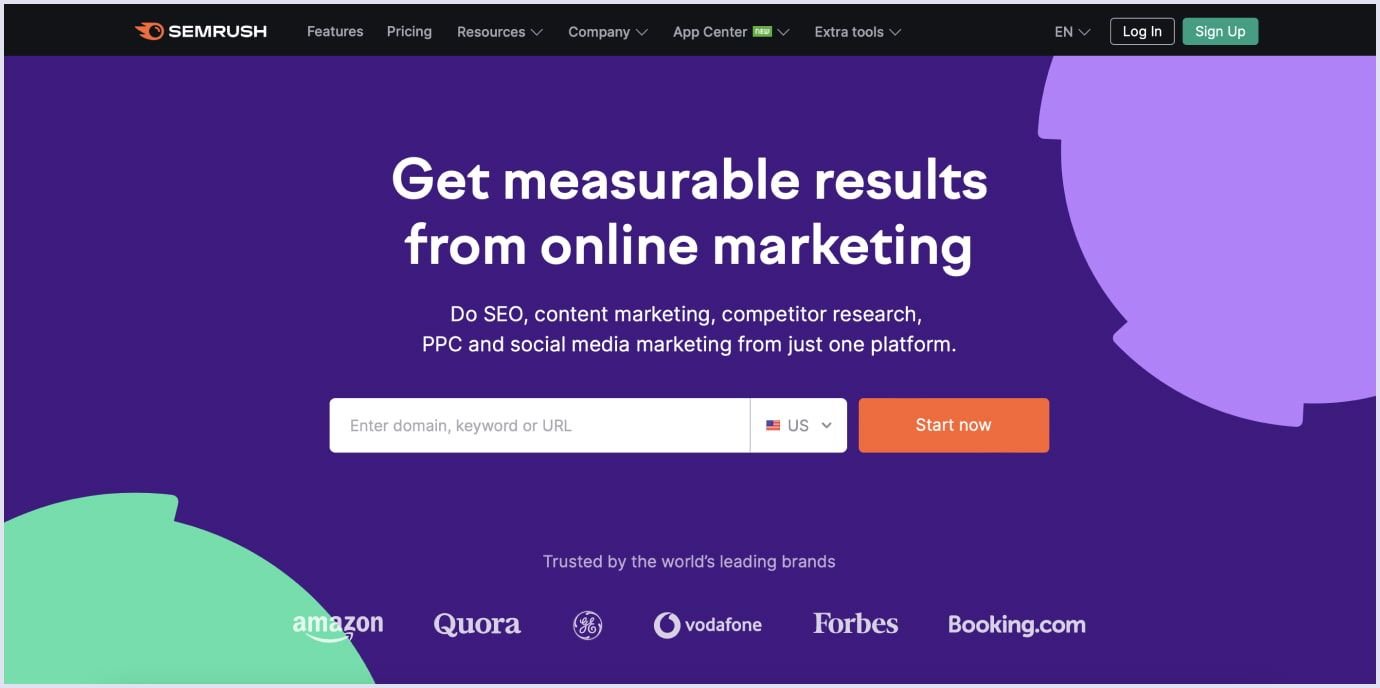
To drive keyword research, you can use the following tips:
- Identify the main topics or themes of your SaaS product.
- Use different tools to identify keywords related to these themes that your target audience is searching for.
- Focus on long-tail keywords that have lower search volumes. These keywords are more specific and targeted to your audience, making them more likely to convert into leads or customers.
Step 4. Topic clusters
In general, a topic cluster is a group of content that revolves around a particular topic or theme, with each piece covering a specific aspect of the subject. Such a strategy consists of one pillar and clusters. Content research and selection of topics that match your keywords are conducted, and a strategy is developed to create content that supports your topics and keywords.
For further explanation, watch this excellent brief video from Hubspot:
It is essential to understand that clusters are built as components of a pillar: to create a cluster, you must first make a pillar. Then, create a pillar page that provides an overview of the topic and links to more detailed content on subtopics related to the pillar page. This approach helps to establish your authority on the subject, improve your website's SEO, and provide value to your target audience.
Here’s a visual guide to what a topical content cluster might look like.

Step 5. Technical SEO for SaaS
First, technical SEO is crucial in optimizing SaaS companies' website structure, performance, and indexing. By implementing the technical SEO best practices, you can enhance the user experience of your SaaS product, leading to improved organic rankings and increased organic traffic.
It’s essential to understand if your technical SEO is off, your site won’t rank. So, no matter how great your content is, technical SEO can be more important in most cases. SEO is a foundation for other essential optimization strategies, such as content, backlinks, and on-site SEO.
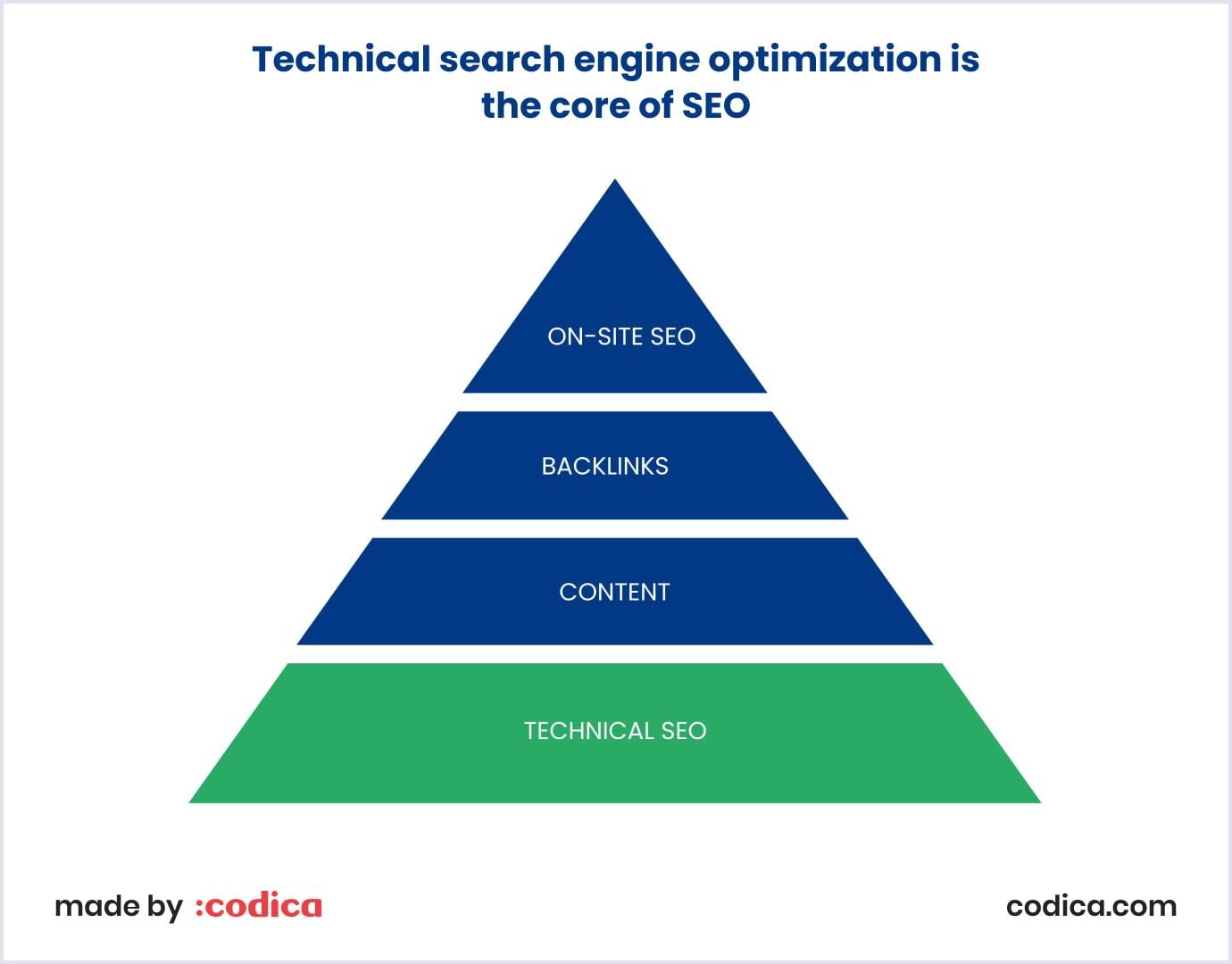
When optimizing for technical SEO, you can start by the following:
- Loading speed and mobile responsiveness. Use tools like Google PageSpeed Insights or GTmetrix to identify issues impacting your website's performance, such as large images, bulky code, or server response times.
- Check your website's structure and ensure it is optimized for search engines. This includes ensuring that your website has a clear hierarchy of pages, using descriptive URLs, and optimizing your website's meta descriptions and headings.
- Ensure that your website is free of broken links. This improves user experience and signals to search engines that your site is reliable and well-maintained.
- Use Secure Sockets Layer (SSL). It can improve user privacy and security, enhance trust and credibility (higher click-through rates, lower bounce rates, and increased conversions), and provide a positive ranking signal (better search visibility).
- Configure robots.txt and sitemap.xml. The robots.txt file communicates with search engine crawlers, providing instructions on which parts of a website should be crawled and indexed. Then, a sitemap.xml file lists all the pages on your website, providing a structured map for search engine crawlers.
Step 6. Content strategy
Obviously, content is critical for driving traffic to your SaaS product and improving your website's search engine optimization. Therefore, a content strategy involves creating high-quality, relevant, and engaging content that provides value to your target audience.
At this stage, you must decide what content matches your keywords and topics. This content can be a blog, webinar, video, podcast, infographic, or other medium.

To create a content strategy:
- Specify your target audience and create content that addresses their needs and pain points.
- Create a list of topics and themes related to your SaaS product that your target audience is interested in.
- Make a content calendar and schedule for creating and publishing new content.
- Promote your content on social media, email, and other marketing channels to drive traffic to your website.
Step 7. On-page optimization
It would be best if you optimized the pages for your keywords and topics. This can include optimizing URLs, titles, meta tags, and images, using keywords in the text, adding interactive elements, and more.
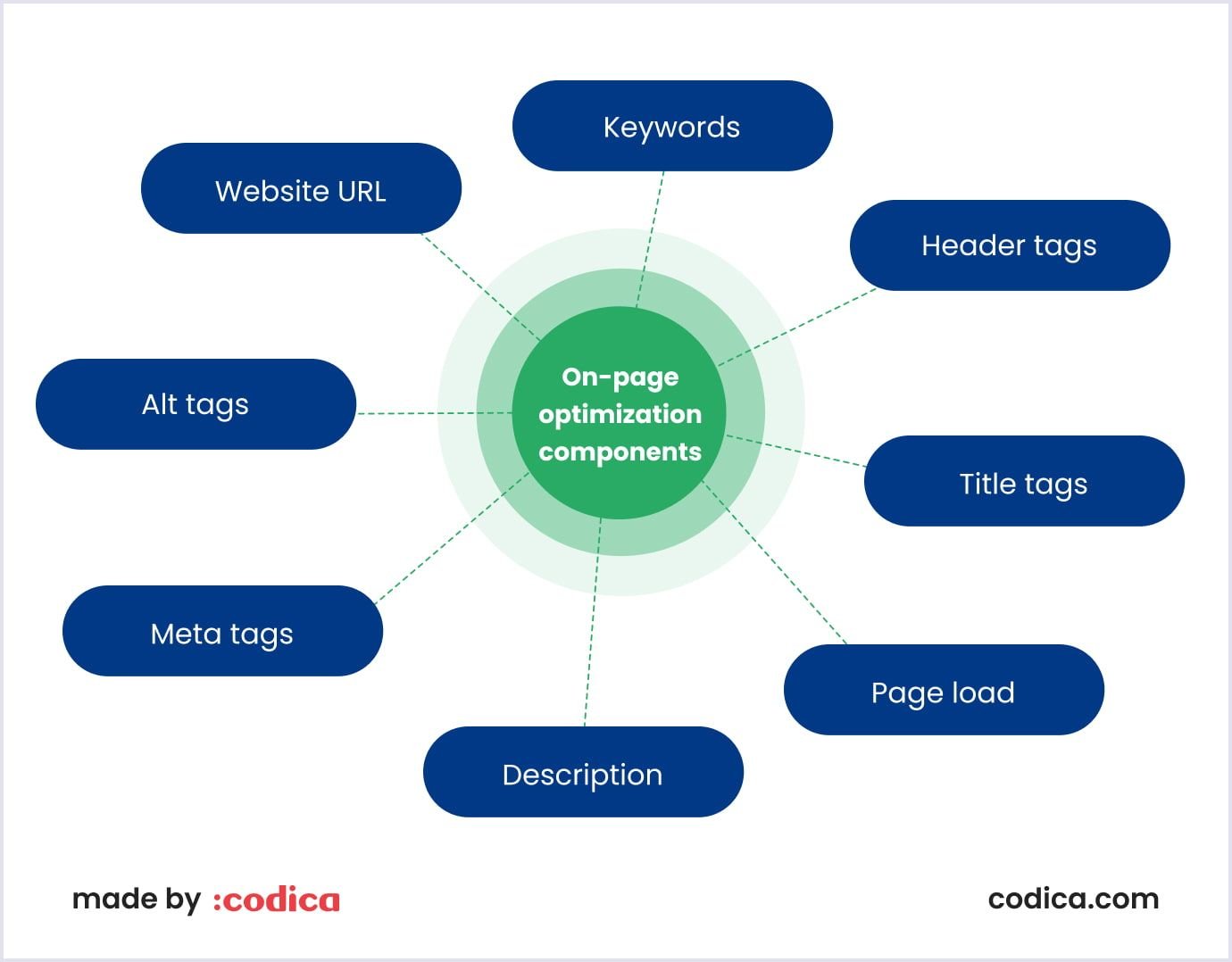
By the way, unique text is an essential component of SaaS SEO, as it ensures optimal SEO ranking of the website. Unique content attracts users' attention and provides high traffic to the site, increasing its popularity and productivity.
To optimize your website's on-page SEO, pay attention to the following :
- Conduct a keyword analysis to identify the most relevant keywords for each website page.
- Optimize each page's title tag, meta description, and headings for these keywords.
- Ensure that your content provides value to your target audience.
- Structure your content for readability and scannability, including bullet points, subheadings, and short paragraphs.
Step 8. Link building
Foremost, link building is critical for improving your website's authority and visibility in search engines. At this stage, you need to create a link-building strategy that includes finding backlinks from high-quality pages, working with experts in your industry, using social media, and more.
So, if you want your website’s pages to rank high in search, you will almost certainly need links. There are some general concepts of evaluating links that the SEO community believes to be true.
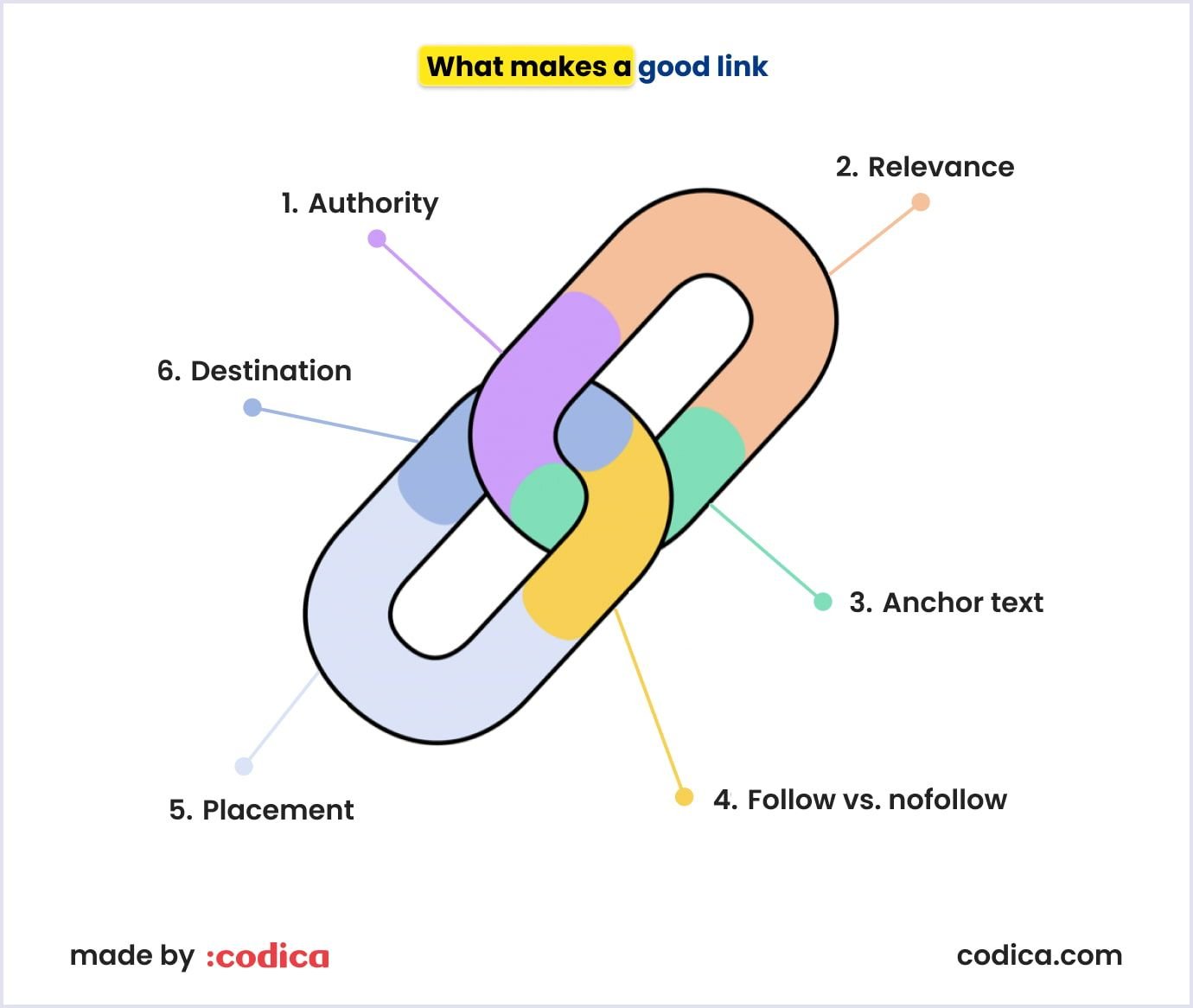
To build high-quality backlinks:
- Create captivating content that provides value to your target audience.
- Reach out to other authoritative websites in your industry and ask them for guest posting and link exchanges.
- Monitor your backlink profile and disavow any low-quality or spammy backlinks.
To sum up, all stages must be interconnected and coordinated to achieve the most outstanding result. Our experts recommend using analytics and performance monitoring to determine the effectiveness of your SaaS SEO strategy and make adjustments as needed.
By the way, it is also essential to understand that different types of links serve various purposes and contribute to SEO in different ways:
- Internal links. They help search engines understand the website's structure and hierarchy, making it easier for them to crawl and index the site. These links also help distribute link authority across the website and assist with user navigation.
- External links. They can provide additional context and value to your content by citing reputable sources or providing further information. Search engines consider external links as signals of trust and authority, especially from high-quality and relevant websites. To check all external links of a website, you can use different tools. For example, one such tool is External Link Checker by Sitechecker.
- Backlinks. They are considered among the most influential factors in determining a website's authority and rankings in search engines. Quality is more important than quantity when it comes to backlinks.
- Anchor text. This is the clickable text within a hyperlink. Using descriptive and keyword-rich anchor text can help search engines understand the topic of the linked page and improve its visibility for relevant searches.
- Nofollow and dofollow links. They are link attributes that indicate to search engines whether to follow or ignore a particular link.
Moreover, it would be best to keep up with your competitors regarding link-building rates. Let's say your competitors employ an average of 50-60 links per month; then, you should do the same or better. It is vital to avoid all websites from gray niches and not to publish your articles on them.
Read also: SaaS Marketing Strategy: How to Promote a SaaS Startup
List of advanced SaaS SEO tools we use in Codica
Our team provides you with a list of advanced SaaS SEO tools you can explore. Thus, these tools can help you with various aspects of SEO, including keyword research, backlink analysis, competitor research, rank tracking, and technical SEO auditing. It's essential to assess your SEO goals and choose the tools that best fit your needs and budget.
Let's list the following SaaS SEO tools we actively use for SEO:
- Ahrefs;
- Ahrefs’ SEO toolbar (browser extension);
- Semrush;
- Moz;
- Google Analytics;
- Google Search Console;
- Screaming Frog;
- Google PageSpeed Insights;
- Schema Markup Testing Tool.
On the other hand, there are also other effective and valuable SaaS SEO tools. At Codica, we do not use them in our practice, but they can help your business improve its online presence and drive traffic to your websites.
- SE Ranking;
- Surfer;
- SimilarWeb;
- Google Trends;
- Majestic.
Related reading: SaaS Business Model Explained: Definition, Tools, and Metrics
Essential SaaS SEO tips from Сodica experts
Our SEO specialists are ready to share with you insights about SaaS SEO. You have the opportunity to analyze all the tips before starting to use an SEO strategy for your SaaS product.
Understand your audience
Research who uses your SaaS product and how they search for your services. You need to understand their needs, language, and other factors influencing their search behavior.
Optimize your content
Create content that answers your audience's queries and contains the keywords they are searching for. The content of your SaaS product should be interesting, valuable, and relevant to your audience.
Develop a link-building strategy
Link building is one of the most critical factors affecting your site's ranking. Develop a plan to get quality links to your site using guest posts, joint publishing, and other methods.
Use local SEO
If your business has a physical presence, it's important to use local SEO to ensure your site is relevant to local searches. The Codica team is open to our customers! So we are happy to share the features of our SaaS software development services.
For example, our specialists created a fast-loading, visually appealing, and SEO-friendly SaaS solution for real estate. To make this platform attractive for users, we delivered convenient viewing of the listed real estate and added home and apartment 3D tours.
Moreover, this custom real estate SaaS platform performs equally well on all types of devices. Then, we provided a simple switch between English and Hebrew versions and implemented right-to-left and left-to-right writing.
In the video below, you can see some of the business solutions that our team delivered for this real estate SaaS portal.
Moreover, we integrated maps to the custom SaaS platform to reveal to users the property neighborhood. So, users can choose a suitable property and move to the property page. Also, our team developed the swift search system that brings up the needed property by location. Thus, customers can check the property address and price when hovering at the location point.
Create a mobile-friendly design
More and more users are searching for information through mobile devices, so it is vital to deliver advanced UI/UX design services.
At Codica, our UI/UX designers developed an attractive design for the custom SaaS platform for bakery business. Also, our specialists provided the latest design practices to deliver the best user experience (UX) and improved user interface (UI).
Our team optimized this SaaS-based solution for mobile devices. Therefore, the SaaS platform for CakerHQ looks excellent on both desktop and mobile screens.
In the picture below, you can see the enhanced UX and UI for the SaaS solution for the bakery business.
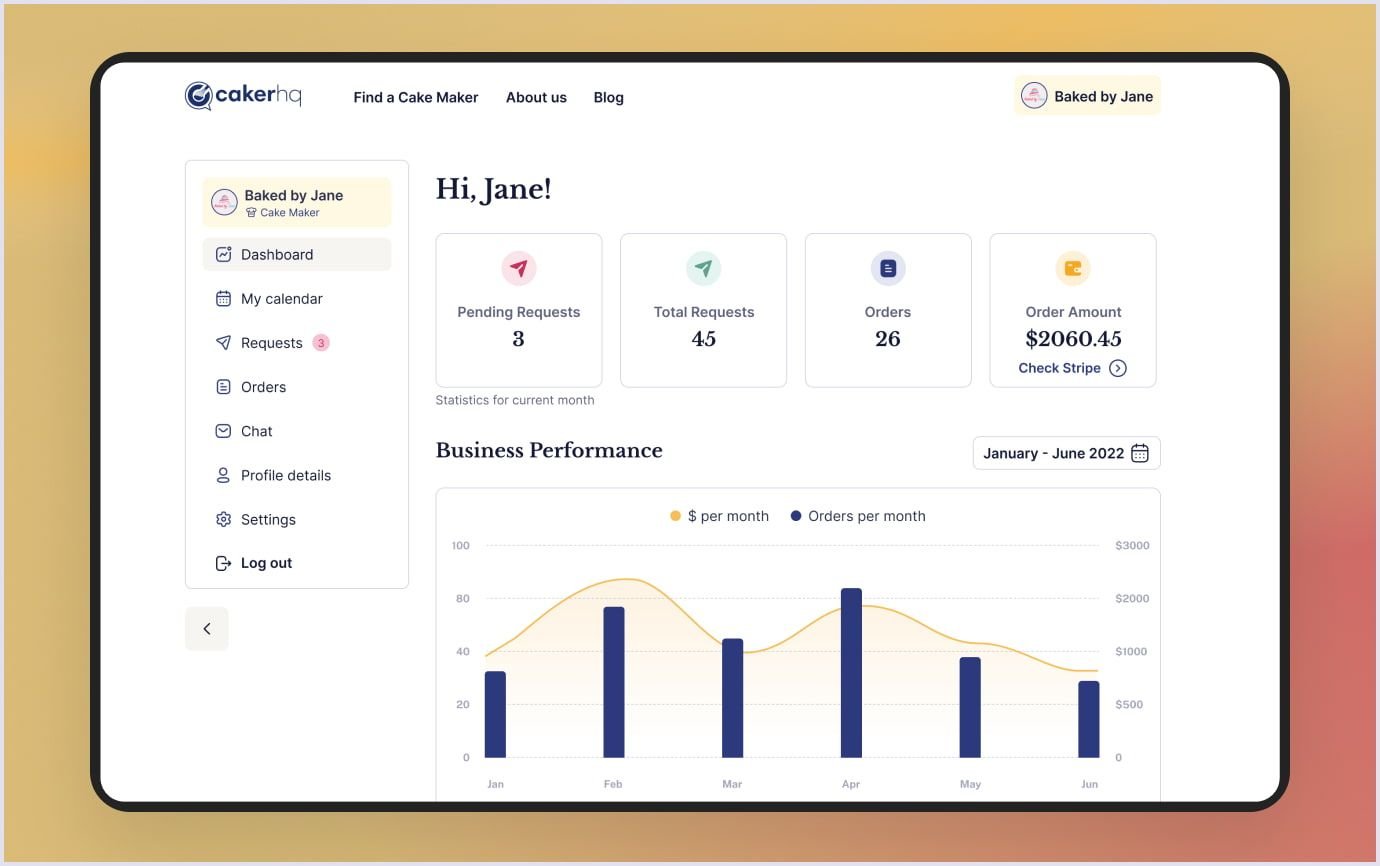
Use analytics
In fact, use analytics tools to track your ranking, traffic, and SEO strategy effectiveness. Analytics will help you determine which methods are working and which need more effort.
Support your strategy
SEO is an ongoing process, and your strategy must evolve with changes in search algorithms and user behavior. Constantly work on optimizing your content and improving your site's ranking.
Use social media
They can help you promote your SaaS product and provide support for your SEO. Create engaging and relevant content for your social media, including keywords and links to your site.
Use a variety of content
Various content, such as videos, infographics, and audio, can help improve your rankings and attract new users. Try diversifying your content and adding new types of content to your SEO strategy.
Collaborate with other sites
Interacting with other sites and businesses can help you get quality links and promote your business. Consider opportunities to collaborate and share content on other sites.
All in all, Codica’s SEO experts are confident that these tips will help you improve your SEO strategy for your SaaS product and ensure its successful promotion in search engines. However, it is worth noting that SEO is a complex and ongoing process. So, it is essential to know that your success depends not on just one tip but on comprehensive work on your strategy.
Be patient
SEO is a long-term strategy, and results may only be visible after a few months or even years. Don't expect instant results; keep going with your strategy if it doesn't produce immediate outcomes.

Final thoughts
In conclusion, SEO for SaaS is integral to the marketing strategy for software as a service companies. Appropriate optimization allows you to ensure higher site visibility in search engines, increase traffic and conversions, attract new users, and retain existing ones.
To be successful in this field, it is necessary to follow the best practices of SaaS SEO, which include keyword analysis, relevant content optimization, and technical aspects of SEO. All these metrics will improve the quality and quantity of traffic on the site, leading to increased profits and success for your company.
In addition, it is worth considering that SEO is a process that requires constant monitoring and updating. New search engine algorithms and changing user behavior can affect the effectiveness of your SEO strategy. So, it's crucial to stay up-to-date and adjust your strategy accordingly.
If you want to turn your SaaS idea into reality, our specialists will gladly help you. Feel free to review our portfolio with successful projects delivered and contact us. We’re eager to help you with your project!
